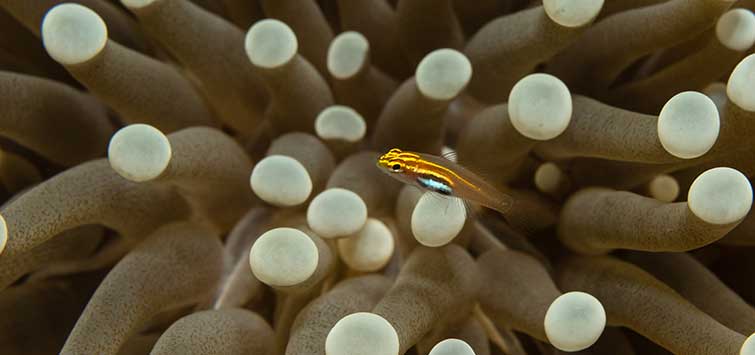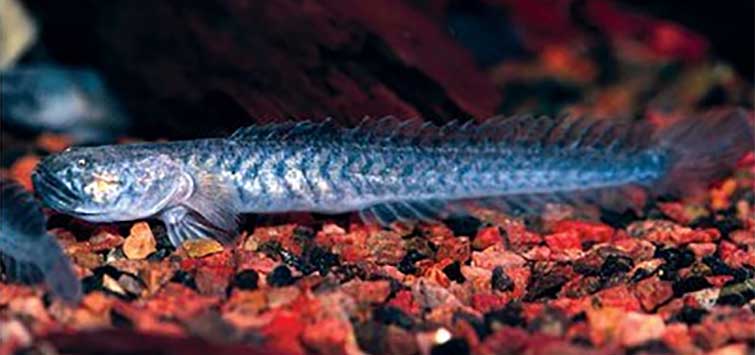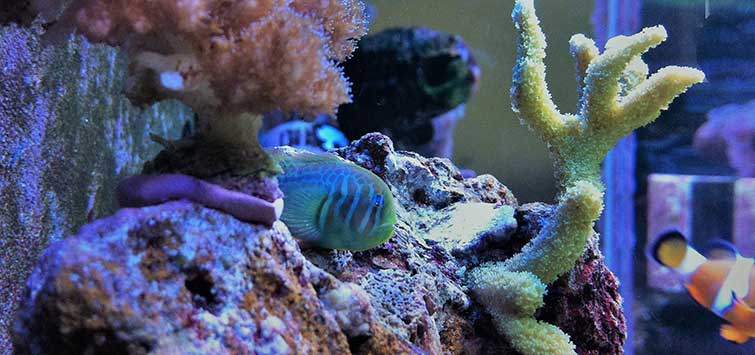Gobies in My Aquarium
Author: Bob Goemans
A look at gobies, peaceful and interesting little marine fishes that adapt well to captive systems, making them excellent reef aquarium fish.
Gobies are members of the world’s largest marine fish family, Gobiidae, which contains 212 genera with almost 2000 species. Almost all gobies in the trade do extremely well in reef aquariums, as they are small, peaceful, and will generally accept a variety of common foodstuffs. And besides being quite inexpensive, they are also quite interesting to watch.
Gobies are often confused with blennies, however, as they look somewhat similar. To tell them apart visually, keep in mind that blennies have only one dorsal fin and gobies have two.
Taxonomy
Gobiidae is an unsettled taxon that presently contains five subfamilies. Mudskippers and other land-dwelling gobies that inhabit mangrove and muddy swamp areas are members of the subfamily Oxudercinae. Another subfamily, Amblyopinae, generally contains brackish or freshwater species, and a third subfamily, Sicydiinae, mainly contains freshwater species. The two smallest freshwater fish in the world, Mistichthys luzonensis and Pandaka pygmaea, are part of the subfamilyGobionellinae, which also mainly contains freshwater species.
The fifth subfamily, and the most important to marine hobbyists, is Gobiinae, containing more than 125 genera. The smallest marine fish Trimmatom nanus is a member of this subfamily. At only 1 cm in length, T. nanus inhabits the shallow reefs of the Western Indian Ocean, including the Maldives.
The fishes in these subfamilies occur in both tropical and subtropical zones, with the marine species generally inhabiting shallow coastal waters around and near coral reefs, where they are bottom-dwelling creatures feeding on small benthic invertebrates and zooplankton.
If you chose carefully, there are many gobies that will do very well in both fish-only and reef aquariums. I can mention a few favorites here that I’ve had in my many different aquariums over the years, along with some that should be given some forethought if you’re eyeing them for your aquarium.
Gobiodon
Some of my all-time favorites are excellent choices for nano aquariums, which I’ve had several ranging in size from 8 to 30 gallons over the past couple of decades. In fact, some of these aquariums were solely devoted to very small species such as those that fall into the genera Gobiodon and Paragobiodon. These are generally called coral gobies because they live in and among the branches of different small-polyp stony (SPS) corals. In fact, their small compressed bodies enable them to fit nicely into the nooks and crannies formed by Acropora or Pocillopora corals.
I’ve often kept the citron coral goby Gobiodon citrinus, which hails from the Indo-West Pacific: the Red Sea and southern Japan south to the Great Barrier Reef. It’s generally found on Acropora corals and attains a length of 1½ inches (3.5 cm). This may seem small, but it’s actually one of the larger coral gobies. It has a varying body color ranging from light tan to yellow, with blue vertical lines behind the head and horizontally placed along the base of the dorsal and ventral fins.
Another little beauty I’ve had on several occasions is the yellow coral goby G. okinawae, which hails from the Western Pacific: from southern Japan to the Great Barrier Reef and the Marshall Islands in Micronesia. It attains a length of a little over an inch (3 cm) and is found in the shallow reefs among Acropora corals.
Another in this genus is G. histrio, which is known under a few different common names, such as the green clown coral goby, the red-lined coral goby, and the broad-barred coral goby. This goby has also been in many of my reef aquariums, small and large. It hails from the Indo-West Pacific: the Red Sea to Samoa, north to southern Japan and south to the Great Barrier Reef. It’s also a little over an inch (3 cm) and can be found in the shallow reefs among Acropora corals. G. histrio is and is often misidentified as G. rivulatus, which is similar in looks and size but has squiggly horizontal stripes, whereas those on G. histrio are slightly broader and straight.
Paragobiodon
Recently, I’ve also had a species in the genus Paragobiodon. P. lacunicolus, the panda or black-finned coral goby, which hails from the Indo-Pacific: Seychells and Chagos Islands to Line and Tuamoto Islands, north to the Ryukyu and Bonin Islands, and south to Lord Howe Island and throughout Micronesia. It’s also small, a little more than an inch (3 cm), and it is only found in the shallow reefs among the branches of Pocillopora damicornis coral. It’s a pretty little fish with a tan body, orange head, and blackish fins.
Pygmy Gobies
Only a few weeks before writing this article I added two new species to my nano tank, the firecracker/candycane pygmy goby Trimma cana, and the neon pygmy goby Eviota pellucida. Neither one is very frequently seen in the trade. T. cana hails from the Western Pacific Ocean: Philippines, Fiji, Marshall Islands, and Palau. It barely reaches an inch (2.5 cm) in the wild, and the one I purchased was less than half that size. E. pellucida is even smaller in the wild, where it does not even reach an inch in length.
The natural diet of these pygmy gobies consists mainly of zooplankton. They make for an interesting addition to small tanks, but in larger tanks with lots of hiding places, they would rarely be seen. Both appear to be faring quite well on the supply of small copepods in my aquarium.
These gobies require a temperature range of approximately 70° to 80°F (21° to 27°C), and they need a meaty diet, (e.g., finely chopped/grated fish or shrimp flesh, fortified brine shrimp, mysis, blackworms, and other meaty type frozen foods) with two or three feedings per day. And, I should note, these small fish are not only ideally suited for nano aquariums, but they would also be “safe” (even if not seen too often) in much larger systems, as they do not make tasty meals for larger fish—they produce a bad-tasting body mucus that turns off most predators. The key word there is “most,” but I’ve never had one eaten by a larger fish in my bigger reef systems, at least as far as I know.
Another small goby is the Catalina goby Lythrypnus dalli, which gets to be about 2 inches (5 cm). I’ve personally collected L. dalli on trips to Mexico in the cooler winter months in the Sea of Cortez (Gulf of California). During summer months these cool-water fish are found in deeper offshore waters, but during the cooler months they are found quite close to shore, sometimes in the local tidepools. They can also be found along the Central Pacific California coastline where the temperature ranges from 65° to 72°F (18° to 22°C). I’ve maintained them in the range of 75° to 78ºF (24° to 26ºC). If the temperature ever exceeded those levels, the fish would become stressed and seek out bottom back areas of the tank.
Elacatinus
Another goby collected in this area during all seasons is the red-headed goby Elacatinus puncticulatus, which is quite prolific in this region. In fact, it can be found all the way down to Ecuador. These little gems are similar in size to the gobies already mentioned, and their diets are also the same.
While I’m on the topic of very small gobies that are quite fitting for small environments such as nano aquariums, the gold neon goby Elacatinus evelynae and the blue neon goby E. oceanops are two of my favorites. Each is no more than a little over an inch (2.5 cm), with E. evelynae hailing from Bahamas and the Lesser Antilles to the northern coast of South America, and E. oceanops from southern Florida to Texas southward to Belize. Both are “cleaners,” as they have well-developed pelvic suckers and are able to hold onto other fish while looking for parasites, which they find and consume. In fact I had a blue neon goby in a fairly large tank that contained a moray eel, and it made numerous attempts to clean the eel around the face/mouth areas. However, there may have not been anything tasty there, as the goby never stayed near the eel’s mouth for too long.
These neon gobies have the same nutritional needs as the ones already mentioned. Only one species of Elacatinus gobies should be kept in each tank (unless the tank is very large), as they can be feisty, especially in small aquariums when their companion “species” mate is not of the opposite sex. Do not expect to keep these gobies for many years, as their normal lifespan is quite short, with about two years being the average. Therefore, by the time you see them, they are probably halfway through their natural lifespan.
Cryptocentrus
Cryptocentrus pavoninoides, also called the black-finned shrimp goby, the blue-spotted shrimp goby, or the prawn goby, is found throughout much of the Western Central Pacific. It’s a 5½-inch (14-cm) fish with a large frog-shaped head and a large mouth. It can be confused with C. cinctus, as it looks quite similar, but it can be distinguished by the black spots in the leading dorsal fin. Both are readily available in the trade, and both require a sandy bottom, as they take mouthfuls of sand and filter it through their gill-rakers to extract minute tasty crustaceans. I’ve seen the prawn goby in two different color forms, overall yellow or a brownish-gray color. They are perfectly safe with sessile invertebrates, but they may eat small ornamental shrimp or smaller fish. They also require a meaty diet as noted above for the others.
This species became a slight nuisance in my aquarium. Its favorite sitting place was under a huge rock arch in the back of my 125-gallon reef aquarium where it would sift through mouthfuls of sand it had gotten from the front of the tank. It became necessary to make a plastic “rake” with a long handle to disperse the pile of sand it created every week in the back of the tank. Except for this slight inconvenience, it was an excellent sand sifter.
Valenciennea
Another favorite sand-sifting goby has been Valenciennea strigata, which is known by several common names, such as the yellow-headed sleeper goby, the blue-cheek goby, the blue-band goby, the yellow-faced glider goby, and the pennant glider. It gets quite large for a goby—7 inches (17 cm)—and hails from the Indo-Pacific Ocean: East Africa to Tuamotu Islands, north to Ryukyu Islands, south to Australia, including Lord Howe Islands, with the more colorful ones coming from Australian waters.
They have a temperature range of 72° to 82°F (22° to 28°C), and their natural diet consists mainly of benthic invertebrates. Even though they are major sand sifters, as are the two above-mentioned species, they will take a wide variety of frozen or flake foods. I’ve found them to be fairly easy to maintain on small sinking enriched shrimp meal pellets, which, as much as they seemed to like them, did not stop them from sifting sand throughout the aquarium. Unfortunately, no matter how well they are fed, some seem to waste away, which could be a sign of intestinal worms.
Keep in mind these are burrow dwellers that will normally seek protection under low overhanging rocks or burrow underneath rocks to form a secure home. In fact, they have actually caused some live rock in my aquariums to tumble, as they were unrelenting when it came to tunneling in a preferred area. Furthermore, they should be housed in aquariums with a sandbed of at least 2 inches (5 cm) in depth. They should not be kept with aggressive fishes such as groupers, dottybacks, triggerfishes, or aggressive angelfishes. Also keep in mind that, because of their size and large mouth, they may also eat small fishes such as neon gobies.
Amblygobius
The Rainford’s goby Amblygobius rainfordi has been in several of my past aquariums. This very pretty species hails from the Western and Central Pacific and gets to about 2½ inches (6.5 cm) in the wild. Most specimens are now coming from the Coral Sea, where they are generally found near the base of corals searching the substrate for tiny tasty crustaceans. They have a very peaceful temperament and are well suited for the reef aquarium, since they will not harm sessile invertebrates. As with the others mentioned above, they require meaty type foods, however, this species should also be offered some greens.
For More Information
In closing, there are many different gobies to choose from, and many make excellent aquarium residents, whether for fish-only or reef systems, and many are suitable for nano tanks as well as for larger setups. If you desire more information about them (including photos of them), visit my website at saltcorner.com and go to the “Animal Library.”

.png?h=595&iar=0&w=2781&hash=5FD5E69473BCC22199FBFA2FB71B6033)



